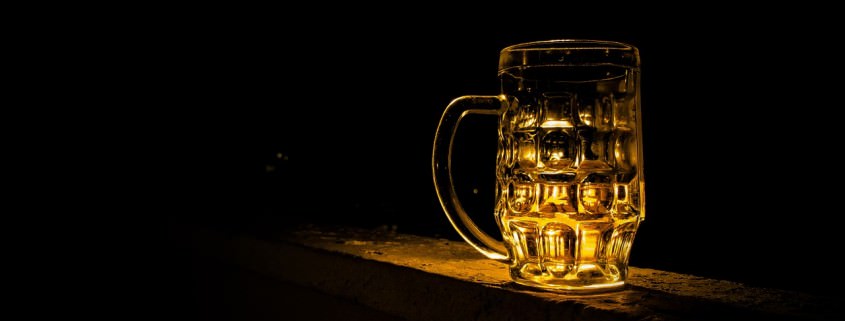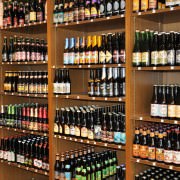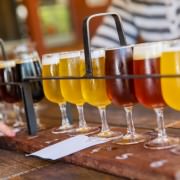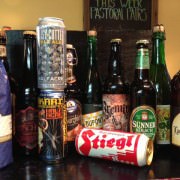The Beer Glassware Guide
It’s a known fact that the shape of a glass is vital when it comes to drinking wine, but what about its affect on beer? Can glassware really make your beer experience better, or is it just a marketing strategy used by restaurants to get people through the door? We decided to take the case and found 10 glasses used across the world that cater to an array of brews.
1. Flute Glass
Say again? The flute glass? Isn’t that just for champagne? Surprisingly, the flute glass is well suited for beer, since the long and narrow body ensures that carbonation stays put. When used for beer specifically, stems can be shorter in the design. A few beer types it can be used for are German Pilsener, American Wild Ale and Eisbock.
2. Pilsner Glass (Pokal)
This 12-ounce glass is faintly shaped like a trumpet, with an opening that slims as it reaches the base. It helps to keep the sparkling aspects and color of a Pilsner, while keeping the flavors intact. Use with American Pale Ale Lager, Euro Dark Lager, and Schwarzbier.
3. Goblet (or Chalice)
Goblets range from the simplified short cup to intricate long-stemmed pieces adorned with artwork. They can be composed of a thick, sturdy glass or be thin and delicate. Some are crafted to maintain a 2 centimeter head, which is done by scoring the bottom of the glass to help with the bubbles. This glass works best with Belgian IPA, Belgian Strong Dark Ale, and Tripel.
4. Pint Glass (or Tumbler)
This is the most famous of the beer glasses, as many restaurants and bars use the pint style as the standard way of serving beer. It has a wide mouth and a cylindrical body and comes in a 16-ounce and 20-ounce forms. This glass works with an array of beer and is one of the cheapest cups to get made. A few beers we thought were worthy of mentioning are Imperial Stout, English Brown Ale, Farmhouse Ale, and English Pale Ale.
5. Stein (or mug)
These are sturdy pieces that come with a handle on the side for easy carrying. The large glasses are meant for holding vast amounts of beer and can sometimes have a lid attached (which was used to prevent flies from dropping in during the Plague). Beers that do best with the stein form are many, like American Amber, Black & Tan, and Irish Dry Stout.
6. Stange
The Stange glass is of traditional German style, since stange means stick. They are tall, slender glasses that have a cylinder-like shape. Use these when serving more delicate beers, like Altbier and Gose, to boost the malt and hop essence.
7. Snifter
These are most famously used when serving brandy or cognac, but work just as well for beer. The short glasses with large mouths are perfect for giving off aromas of a beverage. They work similar to a wine glass, allowing room for the alcohol to be swirled and inhaled. American Barleywine, Belgian Strong Dark Ale, and Export Stout.
8. Tulip
Similar to the Snifter, the glass is short with a wide mouth. It holds the shape of a Tulip (surprise!) that includes a stem and a bulge towards the middle. Use with Scotch Ales, Imperial IPA, and Belgian Dark Ale.
9. Weizen Glass
This glass was made for Weizenbier, but can be paired with a variety of others as well. The thin-skinned glass opens at the top and slims as it reaches the bottom. The long glass allows the colors of beer to shine and aromas to flow. The beer styles that work best are American Dark Wheat Ale, Hefeweizen, and Dunkelweizen.
10. Over-sized Wine Glass
A wine glass for beer seems like a contradiction, but this type of glass with a large opening and round shape is best suited for Belgian Ales. This glass’s style lets the aromas loose, catering to any beer connoisseur’s needs. Other than Belgian Ale, try with American Double, Belgian IPA, English Barleywine and Wheatwine.
Change up your restaurant’s glass types to create a more aesthetically appealing experience while properly serving a beer. The glass helps bring out the taste, aromas and colors of a beer that you wouldn’t get from sipping out a can, bottle, or standard glass.
- Sommelier Surge in Restaurants - August 7, 2015
- 3 Up-and-Coming Restaurant Industry Trends - August 6, 2015
- Millennial’s Impact on the Wine Industry - August 4, 2015









